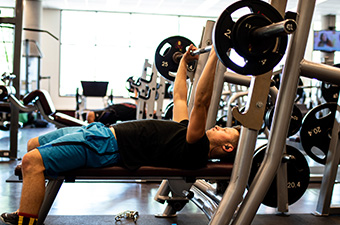PPL, UL and what it all means
Have you ever gone to the gym and wondered, “What body part am I going to work today?”
Well, you’re definitely not the only one! Getting to the gym is the easy part — but figuring out what to do when you get there can be a lot more complicated. There are several ways you can train your body in the weight room throughout the week, and these are called “splits.”
What’s the best split for you? The two most common types are push, pull, legs (PPL) and upper, lower (UL).
PPL is a split that usually allows you to hit the gym anywhere from three to six times a week — and you can get in and out with only three to four hours per week! This set-up seems weird at first, but it’s really easy once you understand the concepts.
Think about your pull muscles — back, biceps, traps and forearms. Each movement you could do for these muscle groups include pulling some kind of barbell, dumbbell or cable toward your body.
For the push movements, you use the following muscle groups — chest, shoulders and triceps. Once you’ve realized which movements are considered push and which are pull, it’s easy to combine the groups into two different days.
One in every three days of your PPL split should obviously be legs. You will need to do at least one squat and one deadlift variation to train your lower back and all muscle groups in your legs — the calves, glutes, hamstrings and quads.
The PPL split is quite popular and it is the most effective at allowing your body to move in a wide range of motions. That being said, it can also be one of the hardest to maintain without proper nutrition, rest or workout-programming. This split is also not ideal if you want to maximize the weight you can lift.
With the UL split, you can expect to be in the gym around four or five days per week. This split makes every upper body day a full upper body day and every lower body day a full lower body day.
UL also allows you to create supersets — exercises that you can combine back-to-back in order to hit antagonist muscle groups without wearing them out. It also allows you to hit a wide range of muscle groups using both compound and isolation movements.
If your main source of exercise is lifting, or if you have a fast recovery rate, this split is probably for you. However, UL can create exhaustion very quickly due to the frequency of the split and if you give yourself minimal rest, so be careful!
Both splits have pros and cons to their setups — it simply depends on what makes you most comfortable. You can also combine the two with an upper, lower, rest, push, pull, leg and rest. Any split that gets you the results you want both physically and mentally is the split for you!
A helpful gym tip is to have your workout written out beforehand, or you can even save an Instagram video to use once you get there. Don’t be afraid to ask for help or if someone is using this dumbbell or that machine — we’re all in this to get our sweat on and build our best selves!
For more information, visit:
https://www.mindtomusclefitness.com/what-are-the-best-training-splits/
https://www.tigerfitness.com/blogs/workouts/best-workout-split-analysis
http://www.healthylivingheavylifting.com/why-push-pull-is-the-best-split-period/
